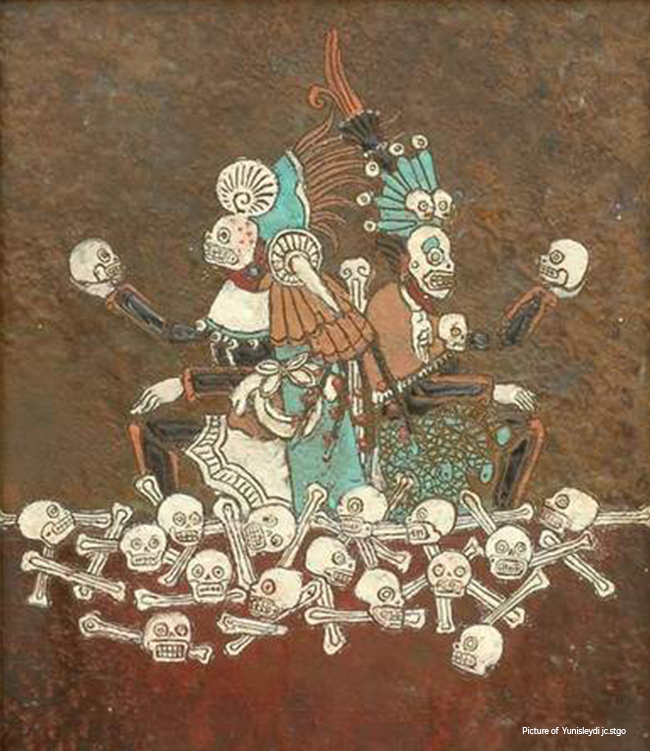

 Mictlantecuhtli and Mictecacíhuatl, Yunisleydi jc.stgo
Mictlantecuhtli and Mictecacíhuatl, Yunisleydi jc.stgo
The Day of the Dead, celebrated in Mexico on November 1st and November 2nd, has its origins in prehispanic times. Different Mesoamerican peoples worshiped death, but the tradition we celebrate today is related to the cosmovision of the Mexicas, whose conception of death revolves around two divinities: Mictlantecuhtli and Mictecacíhuatl, god and goddess of Mictlān, the underworld, the world of the dead.
The Mictlān consisted of nine regions and only the people who died due to natural causes would go there. Once the person died, they started a journey through these nine levels and they had to overcome a variety of obstacles in order to reach the liberation of their soul. This journey lasted four years and if the dead completed it successfully, they reached their final rest.
The first region of the Mictlān was Itzcuintlán, “place where the dog lives”. In here the dead found Xoloitzcuintle dogs, the breed considered sacred, and the Apanohuacalhuia river, inhabited by Xochitónal, a giant iguana who was in charge of guarding the place. The travelers had to cross the river with the help of one of the dogs, who assisted only the deserving ones, the people who treated dogs well, while the ones who weren’t worthy were left stranded there.
The second section was Tepeme Monamictlán, “place where the mountains meet”. The dead had to cross between two hills that constantly collide and separate. The next level was Itztépetl, “obsidian mountain”, a hill with a path of obsidian that lacerated those who transited it. Then, the dead arrived to Cehuelóyan, “place where there is a lot of snow”, to face cold winds, sharp rocks and a non-stop snowfall.
Pancuecuetlacáyan, “place where people fly and flip like a flag”, the fifth region, was a desert area where there were strong, cold winds and no gravity. The dead had to surf the wind to be able to leave. The sixth section was Temiminalóyan, “place where arrows dart you”, a path in which invisible hands threw sharp arrows to those who were crossing.
After that, the dead would arrive at Teyollocualóyan, “place where you get your heart eaten”. Here lives the jaguar, who eats peoples’ hearts. To avoid this, the dead had to give a stone that simulated the heart. Once they got out of the seventh region, they arrived to Apanohualóyan, “place where you have to cross water”. In here the traveler had to go across the black waters of Apanohuacalhuia, to continue to Chiconahualóyan, “place where there are nine waters”, in which they had to go through nine rivers which involved nine states of consciousness.
This was the final step on the journey of the dead. At this stage, while crossing the nine rivers amidst a dense fog, the extreme fatigue and the impossibility to see would induce a reflection of decisions and actions made in life, leading them to connect with everything that had happened during their lives and eventually, to connect with everything around them. In this way, the dead would become one with the whole, ending their suffering and finally liberating their tonalli (the soul). Then they would be welcomed by Mictlantecuhtli and Mictecacíhuatl.
The ancient rite that originated the Day of the Dead was a way for the living to accompany the dead in this long journey. The ceremony started when someone died, which was announced by shouts and weeps from the elder women. Then, the body was prepared along with personal belongings and delicious food was symbolically offered to the dead.
After four days the body was buried. This was the day that the dead would start their journey through the Mictlān. From that moment, every year for four years the living would perform a ceremony at the place where the body was buried, to continue helping the dead through their pursuit of the rest of their soul.
With the Spanish colonization, many costumes and indigenous traditions, especially spiritual ones were subjected to a process of absorption and acculturation. This rite was no exception. Another important element of the Mexica culture included offerings that the peoples dedicated to their deities. The celebration to Mictlantecuhtli and Mictecacíhuatl was during the month now called November, which remains the month dedicated to this tradition.
That was the way in which the Day of the Dead , as we know it was created. While this holiday is different from the original rituals, it is still rooted in this tradition: death represents joy, transcendency and the return to the origins, the beginning of eternity.
The library is dedicated to the memory of Secwepemc Chief George Manuel (1921-1989), to the nations of the Fourth World and to the elders and generations to come.
access here